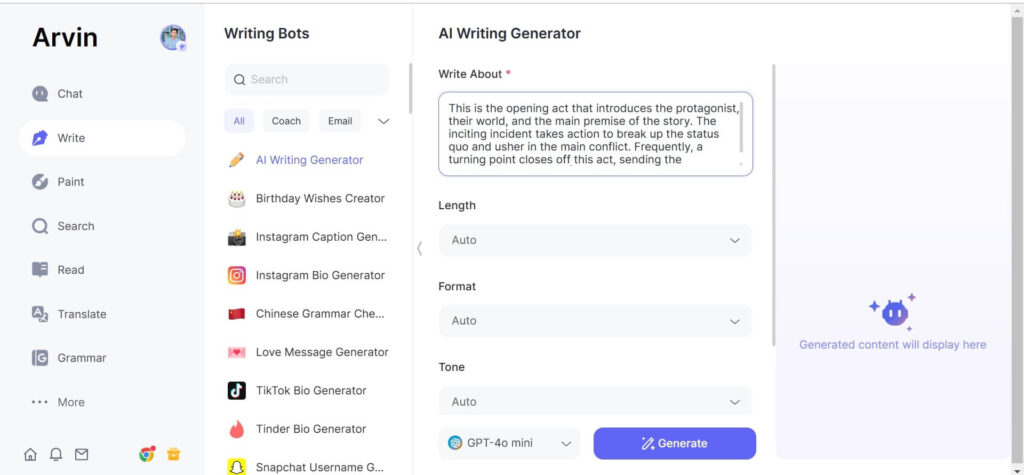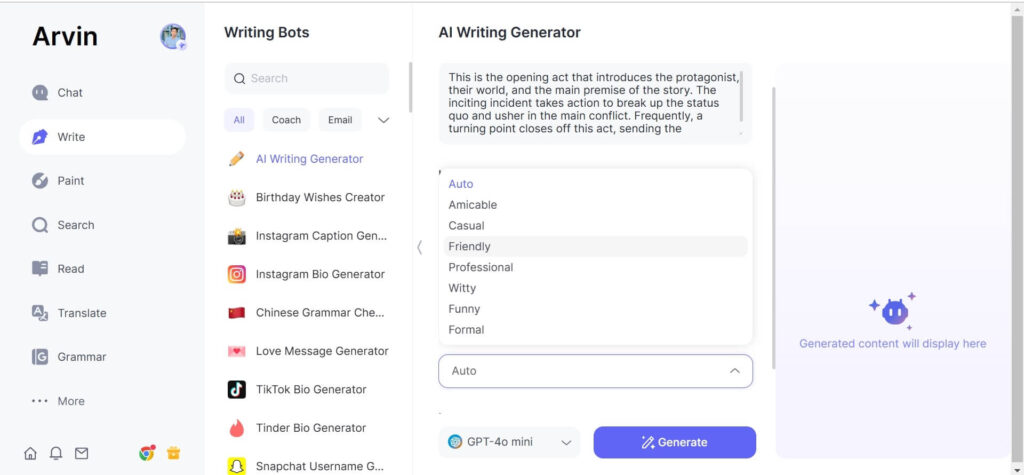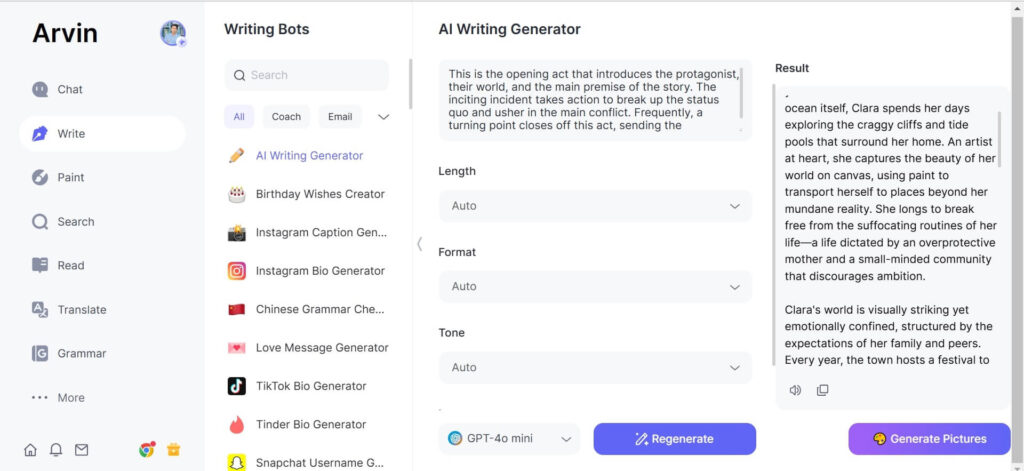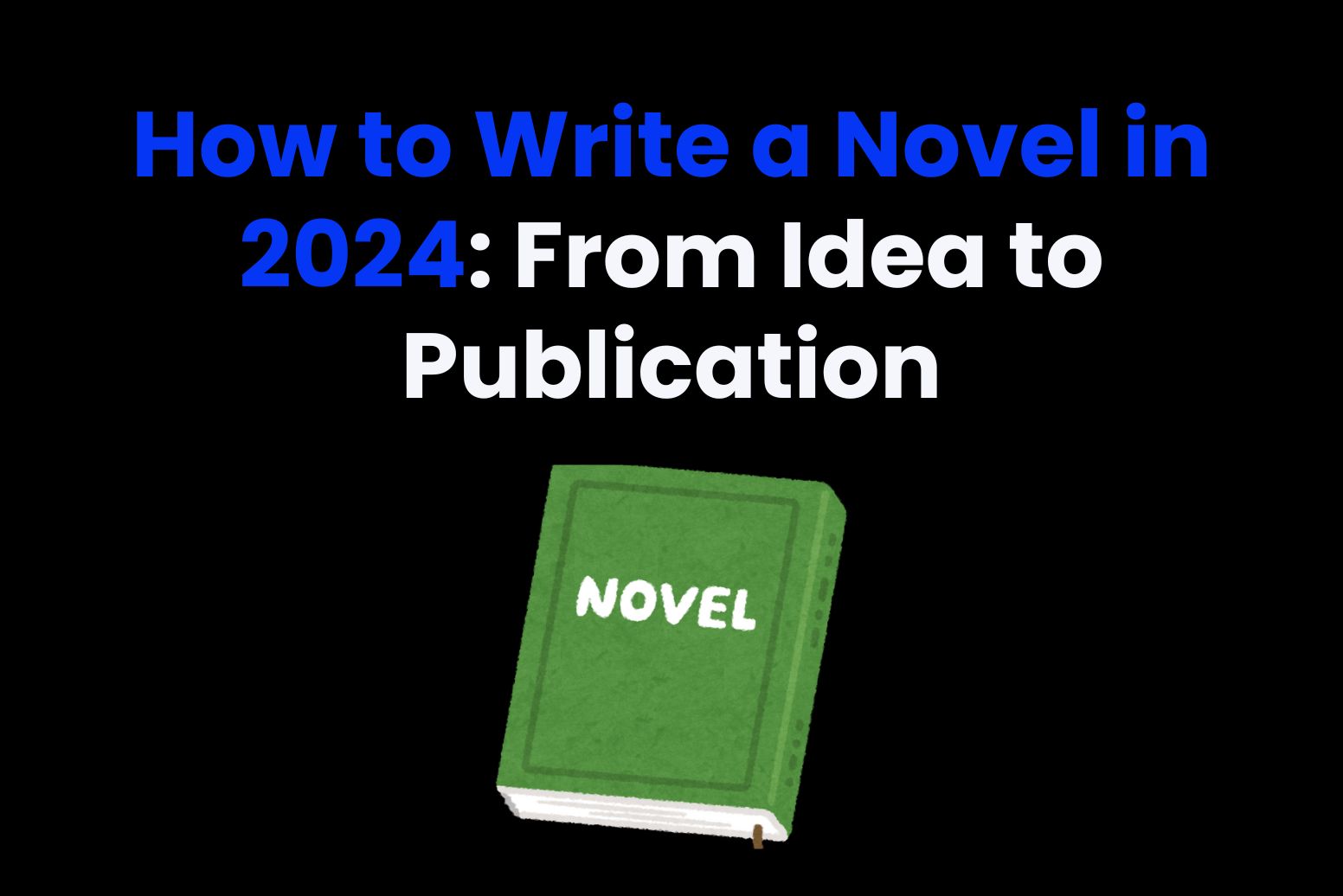Writing a novel is, above all, a really very creative and transformative process for authors to narrate their stories, ideas, and emotions to the world. Storytelling is the art that never ages and unifies people and causes change. In 2025, using tools such as Arvin AI, novice novel writers can count on more aid than ever to make this highly difficult and chaotic process of writing his novels much easier and lovelier. This is a guide which you’ll find at every step in how to write a novel, from idea conception to the printed version of your book in your hand.
Part 1: The Fundamentals of Writing a Novel
Choosing Your Genre and Target Audience
The right genre selection is the basis for your how to write a novel. Bestselling genres include fantasy, romance, mystery, and science fiction-specific audiences with predilections that dictate expectations. For example, while readers of romance novels look for emotional connection and deeply character-driven plots, mystery fans are looking for the thrill and puzzle-to-piece together. Once you’re aware of whom you’re writing for, you can make your story appealing based on their expectations. Research your chosen genre in terms of popular tropes and trends, also known as the fine line between originality and familiarity.
Crafting a Strong Premise
A great premise grabs the reader’s attention and gives your story a lot of direction. It answers the question, what is this story about? The best premises combine unique ideas with universal themes. In The Hunger Games, for instance, the premise is described as a deadly televised competition in a dystopian world. This exciting premise raises questions about life and presents high-stakes drama. When making your premise, clarity and intrigue are most important to ensure it provides enough potential for rich storytelling.
Creating an Engaging Theme
It is what gives a plot depth and meaning-coherence through discussing universal truths or questions. Whether your theme revolves around love, survival, or the conflict of good and evil, that is what connects your readers emotionally to your story.
It then fits naturally in the weaving of your theme with your characters’ journeys and plot. For example, in Harper Lee’s To Kill a Mockingbird, a theme concerning racial injustice seeps deeply within the story of the protagonist, leaving it imprinted.
Part 2: Creating Memorable Characters
Building Complex Protagonists and Antagonists
Your protagonist drives a story so has to be relatable, flawed, and motivated. Consider Elizabeth Bennet in Pride and Prejudice or Harry Potter in J.K. Rowling’s books. These are characters that all experience internal and external conflicts and keep the audience drawn to them. Similarly, a more substantial antagonist challenges the hero, moving the conflict along. Avoid one-dimensional antagonists by giving them some real motivations and a background. Consider Loki in the Marvel universe, who oscillates between hero and antagonist based on his layered personality and desires.
Supporting Characters That Shine
Supporting characters add depth to the main storyline and inject subplots that can enrich your narrative. They may be allies, mentors or serve as comedic relief, but your secondary characters should be memorable and multi-dimensional. Instead of clichés, endow them with some individuality or quirk that prevents stereotyped behavior.
For example, Samwise Gamgee in The Lord of the Rings is more than just a sidekick; loyalty and courage characterize him as part of the journey undertaken by Frodo.
Backstories and Character Development
Backstories provide background to the characters, so that the readers can understand the motivations of their actions and decisions. But avoid info-dumping; information should be gradually revealed through dialogue or flashbacks.
Character arcs characterize growth or change, maintaining readers’ attention. You can manage character development using any free AI writer tools, such as Arvin AI, that includes mapping traits, goals, and transformations. This creates consistent and realistic progress within the story.
Part 3: Structuring Your Novel
The Three-Act Structure Explained
How to write a novel? A classic three-act structure arranges a story into three necessary parts: setup, confrontation, and resolution.
Setup (Act 1):
This is the opening act that introduces the protagonist, their world, and the main premise of the story. The inciting incident takes action to break up the status quo and usher in the main conflict. Frequently, a turning point closes off this act, sending the protagonist into action.
Confrontation (Act 2):
Act 2 is the heart of the story, presenting obstacles and challenges that raise the stakes. The protagonist learns and grows throughout these conflicts, often having to undergo a significant crisis or “dark moment” that pits his will against his fate. Subplots and supporting characters also often flesh out this part.
Resolution (Act 3):
The final act brings the story to its climax and conclusion. The protagonist faces the ultimate challenge, achieving success or failure. Loose ends are tied up, delivering a satisfying resolution to the narrative arc.
Alternatives to the Three-Act Structure
If the three-act structure doesn’t suit your how to write a novel, alternative approaches like nonlinear and episodic storytelling can provide fresh perspectives.
- Nonlinear storytelling: This approach interrupts the chronology of the story-telling and reveals suspenseful or critical details at strategic moments. Examples of this method include flashbacks, parallel timelines, or reverse chronology.
- Episodic storytelling: Appropriate for character-driven stories, this form of narrative is made up of self-contained chapters or sections that are connected through a common theme or by a character, which sometimes is found in adventure or anthology-style novels.
Both techniques offer creative liberty and can capture readers’ attention by playing with the conventional expectations.
Outlining Your Novel Effectively
Writing a novel without an idea or outline is quite challenging, especially in regard to consistency.
Why do you need an outline?
An outline provides you with a roadmap for your story, helping you prevent plot holes and pacing issues. Through it, you clearly get the flow of your work, characters, and themes.
How to write a novel? Start at the top by sketching out the big ideas: where a story begins, the central conflict, and how it ends. Flesh out subplots, character arcs, and settings from there. Consider methods like the Snowflake Method, which builds details incrementally, or the Hero’s Journey for character-driven tales.
Streamline with tools:
Tools like Arvin AI may make outlining so much easier. AI can offer plot structures, generate ideas, and refine your narrative, all saving time and sparking creativity. Using these tools ensures you stay organized and focused on storytelling.
Part 4: Writing Compelling Scenes and Dialogue
Crafting Vivid Descriptions
Creating immersive scenes requires engaging all the reader’s senses.
Show, don’t tell:
Instead of the telling of facts, paint pictures with your words. For instance, instead of writing “It was a cold night,” describe the “icy wind biting through his jacket, numbing his fingertips.” This brings scenes to life and draws readers into the story.
Use sensory details:
Apply sights, sounds, smells, textures, and tastes to make settings and actions feel tangible. Descriptions should serve the story, focusing on emotions, foreshadowing events, or deepening themes.
Balance details:
Don’t drown readers in too many details. Highlight the essentials that create the mood and leave space for the imagination.
Writing Authentic Dialogue
Dialogue can be an excellent tool in character development and plot progression.
Keep it natural:
Write dialogue like people speak, but eliminate extraneous fillers. Avoid overly formal speech unless it is fitting to the character. Read aloud to work on the flow of the dialogue.
Differentiate characters:
Each character must have a distinct voice. Consider their history, personality, and motivations in writing their speech patterns. Slang, idioms, and your tone can give very convincing dialogue.
Use subtext:
What lies beneath the spoken word can be as telling as what has been said. Subtext enriches a conversation while suggesting there’s more going on or unspoken.
Balancing Action, Description, and Dialogue
Action, description, and dialogue should flow smoothly together to sustain an animated pace.
Action propels the story forward; it keeps the reader interested. Description sets the setting, creating mood and atmosphere. Dialogue injects a sense of urgency; it tells the reader characters’ thoughts and their relationships.
Blend naturally:
Avoid long sections of one element. So, break those descriptions up with some dialogue or inject some action within a conversation to create a more dynamic rhythm. Balancing these elements will make your story feel richer and well-paced.
Part 5: Editing and Refining Your Novel
Editing is the step where your first draft transforms into the written and compelling manuscript that will capture every reader’s heart. These are the ultimate stages to make your novel refined.
Importance of the First Draft
The first draft is the basis of your how to write a novel where all ideas spring to life. Writing a “bad” first draft is very acceptable and even crucial as it lets lose any untamed creativity without considering perfection, so you can express yourself freely. Think of this phase as chiseling out a block of marble-it’s rough and unshaped, but it holds the potential to be something magnificent. Don’t bother with grammar, style, or inconsistency in the first effort. Just get your story on paper, knowing that it’ll be refined in subsequent drafts. Many writers claim their first drafts are little more than a sandbox for ideas-a source of material to shape later into art.
Self-Editing Techniques for how to write a Novel
Self-editing is your starting point to turn your draft into a finished manuscript. Here are a few of the important techniques:
- Cut Redundancies: Delete repetitive phrases, unnecessary adverbs, and scenes that do not forward the plot. Streamlining will improve readability and keep your narrative going.
- Focus on Structure: Review the pacing of your story. Make sure each chapter has something towards the climax and that subplots are being resolved convincingly.
- Refine Language: Replace vague descriptions with vivid details. Strengthen your verbs and cut filler words like “just,” “really,” or “very.”
- Read Aloud: Hearing your text helps catch awkward phrasing, unnatural dialogue, and flow issues.
- Use Editing Tools: Consider using Grammarrly as spell-check tools to identify errors, but always rely on your judgment for stylistic decisions.
Self-editing enhances clarity and ensures your manuscript is ready for constructive feedback.
Seeking Feedback from Others
The best thing that improves how to write a novel is the feedback received from beta readers and professional editors
- Beta Readers: Beta readers form the target audience of the book. They can give insights into plot coherence, character likability, and pacing. Fresh perspectives mostly point out any blind spots you might have missed.
- Professional Editors: Many editors have much experience in grammar, structure, and telling a good story. Developmental editors help hone your plot and characters, while copyeditors focus on grammar and style.
Sharing your writing with others can be intimidating, but tough criticism is what makes your work improve. To get the most out of feedback, don’t be afraid of criticism and keep track of repeated suggestions. Working with readers and editors will only make your novel stronger, more gripping, and better for being published.
Part 6: Power of Arvin AI for Novel Writing
A tool by Arvin AI, aimed at empowering a writer through making the creative process and storytelling streamlined. Here’s how it can revolutionize your journey of writing. Arvin AI: Your Best Writing Companion for Novelists: Helping you at every step of your writing strategies, be it just brainstorming ideas to create complex characters or perfecting your prose, the innovative tools of Arvin AI will make you write with confidence. With this state-of-the-art AI writing, Arvin AI helps empower its authors by making complicated tasks easy and finding inspiration for its writers while saving time and letting your storytelling shine.
Key Features of Arvin AI
Arvin AI offers an array of tools specifically personalized for how to write a novel:
- AI-Assisted Idea Generation: Stuck on how to write a novel? Arvin AI suggests unique plot ideas, themes, and twists based on your initial input.
- Character Development Tools: Create multidimensional characters with ease. Define traits, backstories, and relationships while receiving prompts for deeper exploration.
- Scene Outlining: Simplify complex plots with scene-by-scene outlines. These tools help structure your novel effectively, ensuring smooth pacing and continuity.
- Grammar and Style Enhancement: Improve your manuscript’s readability. Arvin AI detects awkward phrasing, improves style, and reduces grammatical errors.
These features combine to help make writing effortless for you, so you can spend more time focusing on telling the story.
How to Use Arvin AI to Write Your Novel
Follow this step-by-step guide to make how to write a novel using Arvin AI.
Step 1: Input Your Story Idea: Provide a brief summary or theme, and let Arvin AI generate creative suggestions for plots and characters.

Step 2: Use Character-Building Tools: Define your protagonist and supporting cast. Arvin AI helps flesh out details like motivations, strengths, and flaws.

Step 3: Generate and Refine Outlines: Start with an AI-generated outlines and customize it to suit your vision. Break down your story into chapters and scenes with Arvin’s structured suggestions.

Step 4: Edit with AI Assistance: Use your grammar and style enhancement tools to refine your draft. Arvin AI will point out areas for improvement, ensuring your manuscript is polished and professional.
By integrating Arvin AI into your workflow, you can improve productivity, break through writer’s block, and raise the stakes on your storytelling. Let Arvin AI guide you in how to write a novel of which you’re proud to share with the world.
Part 7: Publishing Your Novel
Publishing your novel is the culmination of your hard work and creativity. Whether you opt for traditional publishing or self-publishing, understanding the process, preparing your manuscript, and marketing effectively can be the sole determinant of success.
Traditional Publishing vs. Self-Publishing
Traditional publishing:
Submitting your manuscript to agents or publishers, who undertake editing, marketing, and distribution. Advantageous is getting linked with professional networks, credibility, and broader reach. However, disadvantageous considerations are lengthy timelines, no control over the creative decisions, and lower royalty rates. Acceptance is also highly competitive.
Self-Publishing:
You wholly control the process: editing, design, conversion, distribution, with options like Amazon Kindle Direct Publishing making it easier for everyone. Pros: Faster publication, more royalties, and full creative freedom. More negatives include overall management of all costs for editing, design, marketing, etc., and potential difficulties for reaching a large audience.
Choosing the best route depends on your goals, resources, and how much control you want over the publishing process.
Preparing Your Manuscript for Submission
Before submission, ensure your manuscript is polished and professional. Begin with thorough editing, addressing plot inconsistencies, grammar, and punctuation errors. Consider hiring a professional editor for unbiased feedback.
Next, follow standard formatting guidelines:
- Use a 12-point, readable font like Times New Roman.
- Double-space the entire document and maintain 1-inch margins.
- Use a title page detailing your contact information and word count.
- Number each page in addition to including a header containing your name and book title.
For traditional publishing, craft a compelling query letter and outline personalized to the publisher’s submission guidelines. Self-publishers should ensure their manuscript meets the technical requirements of platforms like Amazon or IngramSpark. A well-prepared manuscript demonstrates professionalism and increases your chances of success.
Marketing Your Novel Successfully
Reach readers and build your audience marketing. First and foremost, gets your online presence going. In this case, use Instagram, Twitter, and TikTok. Share behind-the-scenes writing processes, excerpts, character insights, and more. Use personal appearances through book signings, virtual readings, and other activities to reach readers in person. Review bloggers and influencers collaboration will really help bring eyes on you. For self-published authors, Good reads and Amazon Author Central also help with discoverability. Use your email newsletters to let fans know about your book launch and other activities.
Conclusion
Such a journey to how to write a novel and publishing a novel, Swallow the highs and lows because they shape you into a more powerful and capable writer. After all, every great author had to start from somewhere, failing and facing rejection. Persistence with learning and adaptation is your key to achieving your dreams. Be happy about everything no matter how small, and keep pushing forward. Make your writing journey smoother with Arvin AI. It aids in the brainstorming of ideas, manuscript-refining, and even in marketing content.
FAQs About Publishing Your Novel
What’s the difference between traditional publishing and self-publishing?
Traditional publishing sends your manuscript off to publishers or agents, who take care of the work of editing, marketing, and distribution, while self-publishing keeps all control in your hands but leaves all costs to you for editing, cover design, and marketing.
How do I get my manuscript ready for submission?
Make sure that your manuscript is professionally edited and formatted for the industry. Use a readable font for how to write a novel, double spacing, and include a title page with all of your details. In addition to these preparation steps for traditional publishers, prepare a query letter and synopsis tailored to each specific publisher’s needs.
What are the best strategies to promote my book?
Share teasers or character insights on social media to create an audience. Host book signings and virtual readings; partner with reviewers of books; leverage Goodreads and Amazon Author Central for better discoverability.
How will Arvin AI be useful in my novel-writing process?
Arvin AI offers brainstorming ideas, manuscript refining, and marketing content creation. It simplifies the writing journey while helping authors get through this with maximum efficiency whether it’s drafting, editing, or promoting a novel.






